Strip Heater
Introduction to Strip Heaters
What is a strip heater used for?
OMEGALUX™ strip heaters are used principally for convection-type air heating and clamp-on installations. When selecting strip heater elements for either, two important factors must be considered:
- The proper sheath material for resisting any rusting and oxidizing inherent in the process or environment and for withstanding the sheath temperature required. Standard sheath materials are rust resisting iron, chrome steel and Incoloy (NS Series only). Stainless steel and Monel sheaths are available at an additional charge. Maximum work and sheath temperatures are below.
- The watt density of the heater element, or watts per square inch of heated area. This should be low for heating asphalt, molasses and other thick substances with low heat transferability; it can be higher for heating air, metals and other heat conducting materials. (See curves for determining allowable watt densities).
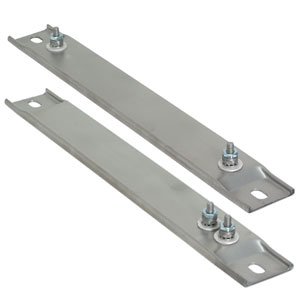
Choose the right Strip Heater
Selecting Sizes and Ratings
The calculation of total heat requirements for an application is outlined in the Technical Section. For assistance, get in touch with an OMEGALUX™ applications engineer who will be glad to help solve your heating problem. Once total heat requirements are established, the quantity, size and ratings can be decided. Plan for enough strip heaters to permit even temperature as required by the process. The sensor for the temperature control should be clamped to the working surface for accurate control. In the case of air heating, place sensor where the desired temperature is needed, but not too far from heater to help avoid undershoot and overshoot.
After the specific heater element size and rating has been tentatively selected, the watt density must be checked against the appropriate curves. For example, the OT-4315 chrome steel sheath heater rated 1500 watts has a watt density of 11 watts/sq. in. and can be operated at 1200°F sheath temperature. If clamped to a work surface operating at 600°F, Figure
C-1 shows that the maximum allowable watt density is 12 watts/sq. in. Since the watt density of the OT-4315 is below the maximum allowed, good clamping will provide long service. If the strip heater selected has a watt density higher than that stipulated by the graph, then these alternatives could be considered:
- Use more heaters of a low watt density to obtain the required kW capacity.
- Reduce the kW capacity needed by reducing heat losses and allowing for a longer heat-up time.
Choose the strip heater
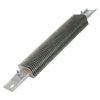 Ceramic Finned Strip Heater
Ceramic Finned Strip Heater
Finned strip heaters are extremely efficient and dependable as a heat source for hundreds of industrial and commercial applications. They are used for both forced and natural convection air heating.
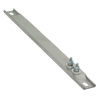 Channel Strip Heater
Channel Strip Heater
Channel Strip Heaters have proven to be extremely efficient and dependable as a heat source for surface heating in hundreds of industrial and commercial applications. The rectangular tube gives full surface contact when used in a milled slot to provide maximum heat transfer area.
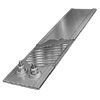 Mica Insulated Strip Heater
Mica Insulated Strip Heater
An economical, practical and reliable heat source capable of providing uniform heat transfer to flat surfaces. Mica insulated strip heaters are used in hundreds of industrial and commercial heating applications.
Learn more about Strip Heater
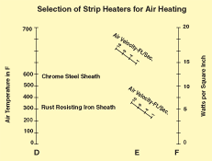
Selection of Strip Heaters for Air Heating
1. Select maximum desired operating air temperature on (D)
2. Choose either chrome steel sheath or rust-resisting iron sheath (points E) on basis of operating conditions
3. Draw straight line through points (D) and (E) to reading on (F) giving maximum allowable watts per square inch
4. Select desired length of the strip heater element with equivalent watt density or less
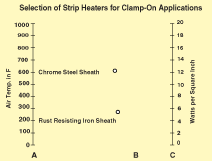
Selection of Strip Heaters for Clamp-On Applications
1. Select maximum desired work temperature on (A)
2. Choose either chrome steel sheath or rust-resisting iron sheath (points B) on basis of operating conditions
3. Draw straight line through points (A) and (B) to reading on (C) giving maximum allowable watts per square inch
4. Select desired length heater with equivalent watt density or less

Selection of Watt Density for Finned Strips
1. Select a maximum desired air temperature on A
2. Choose sheath material to suit operating conditions
3. Select minimum anticipated air velocity on B. Note: Natural circulation is equal to one foot per second
4. Draw straight line through the points selected on A and B - read C for allowable watt density
5. Select required length heater with equivalent watt density or less
When high operating temperatures are needed, watt density must be limited in order not to exceed the maximum sheath temperature. Watt density is given in the "How To Order" table for each strip heater.
In general, a viscous material with low thermal conductivity requires a low watt density. High watt densities can be used with thinner liquids and with materials of high thermal conductivity. Premature loss of the element due to excessive temperature may result if the material's heat-take-away ability is low. Also, the material may be charred, carbonized or its chemical makeup altered by overheating.
Strip Heater | Related Products
↓ View this page in another language or region ↓
 CLOSE
CLOSE








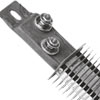





 Éléments Chauffants à Bandes
Éléments Chauffants à Bandes Strip Heaters
Strip Heaters Bande chauffante
Bande chauffante Flachheizelementen
Flachheizelementen Strip heater
Strip heater Strip Heater
Strip Heater Strip Heaters
Strip Heaters 带状加热器
带状加热器 Strip Heaters
Strip Heaters
 스트립 히터
스트립 히터 Strip Heaters
Strip Heaters
 Strip Heaters
Strip Heaters
 Strip Heaters
Strip Heaters
 Strip Heaters
Strip Heaters
 Strip Heaters
Strip Heaters